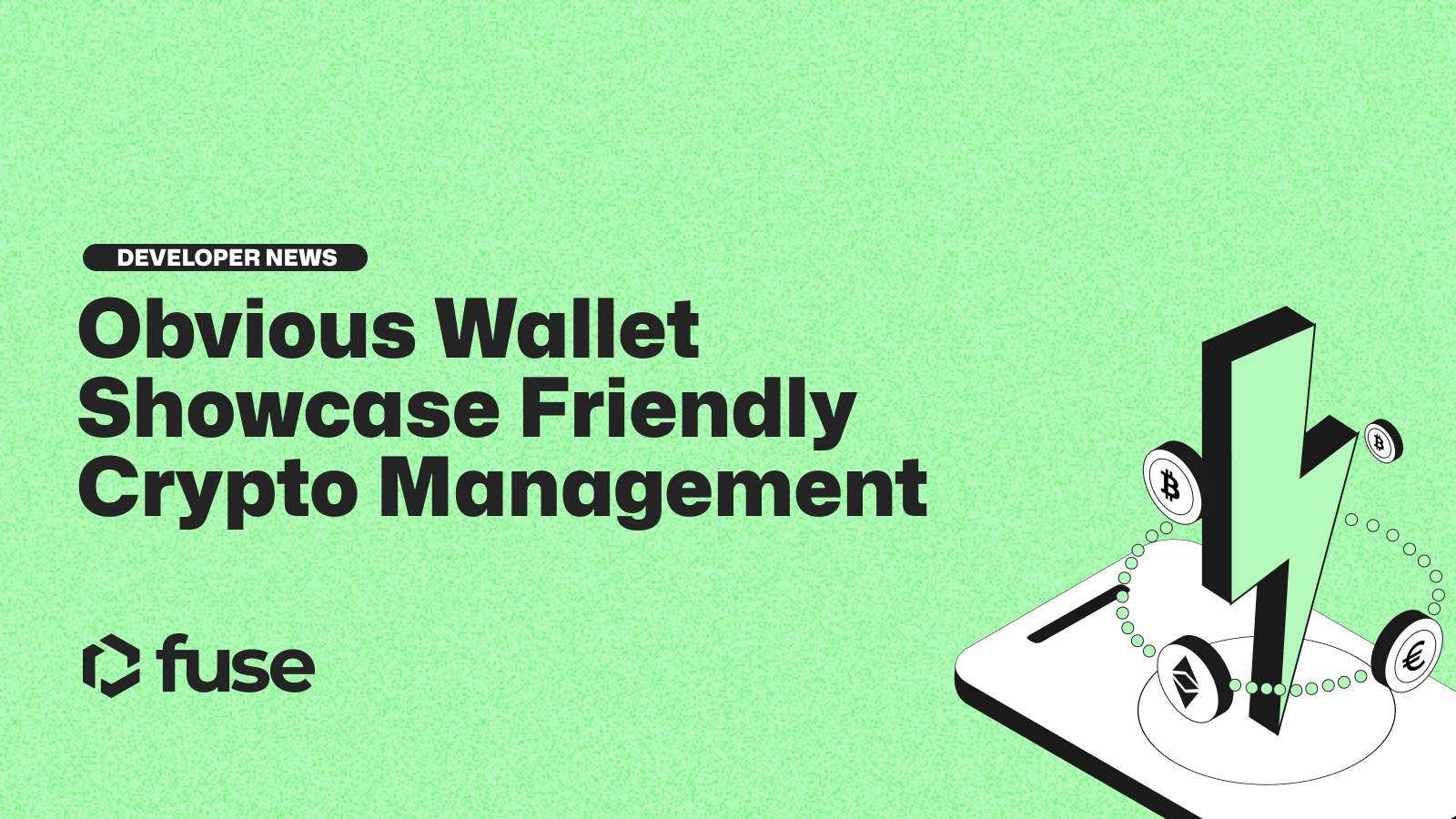Self-custodial crypto wallet Obvious has added support for digital assets on Fuse. Letting users move tokens across leading blockchains and find the best opportunities in a single click.
Obvious Wallet is a self-custody Web3 wallet that combines digital assets across EVM and non-EVM chains to power cross-chain transactions with safe, fast, affordable bridging and swapping routes within the app.
Like Obvious, Fuse believes mainstream crypto adoption will come only when users can manage their digital belongings without worrying about the complexity of the underlying rails.
For those with experience with DeFi and managing and moving tokens cross-chain, Obvious comes as a breath of fresh air.
Moreover, its slick, easy-to-use interface provides a compelling choice for new entrants into crypto. A recent integration with Fuse Network means Fuse community members and token holders can now use Obvious wallet to swap, bridge, store, and track their assets.
Multichain of madness
Fuse believes the future will be multi-chain, and no single chain will dominate the landscape. Ethereum is scaling out with multiple Layer-2 networks to address the massive demand. This trend looks set to continue, and applications will surely pick blockchains that best fit their needs. But, while logical, it introduces several challenges for builders in Web3.
- Developers must deploy and support their dApps on multiple chains to attract liquidity.
- Users are stuck in a labyrinth of wallets managing private keys to separate blockchains.
- Keeping track of assets across different chains and protocols is tricky and complex.
Wallets like Metamask have taken a convenient approach to the multi-chain world by integrating different networks. So far, this model has worked as these networks were mostly isolated with minimal cross-chain traffic. But anyone who uses MetaMask regularly will know the pain points here.
However, with the trend moving towards a mix of chains, with no one chain being the apparent winner, existing wallet models are becoming redundant for mainstream users. Reimagining the multi-chain experience from a user perspective is critical to user onboarding.
The Obvious Vision
It’s long been argued that for crypto to go mainstream, it must first offer services where users are not worried about which chain, wrapped version of the token, or gas denomination the transaction has to be paid in.
Obvious wants to enable a future where users can operate from their wallet in a chain-agnostic manner—removing the pain of managing funds and providing in-app experiences like Venmo or Revolut.
For dapp developers, Obvious let them focus on building the dApp on the chain that best suits their needs. They get to optimize for the chain and not worry about deploying onto other chains. Obvious’ most powerful play is arguably bringing the liquidity and users to the dapps, whichever chain they might be on.
A wallet is where end users will manage funds; that is where Obvious believes the solution for the multi-chain puzzle should exist. With the wallet being the main entry point, this is where Obvious can step in and abstract the complexities of the various chains, tokens, and transactions. Leaving the user with a similar experience to what they are used to in Web2.
Many projects look to solve these problems, but Obvious approached it with a fresh set of eyes and zooms in on five aspects that they feel set them apart. Let’s dive into each one.
Portfolio Management
The Obvious wallet presents an asset-first view where assets are collected across multiple chains and variants. Rather than switching between networks to see the value of assets on each, Obvious pulls it all together into one dashboard.
You can dig down and understand the spread across chains in other views, but the snapshot presented is that of a single asset. For example, if you’re holding FUSE on three chains, you will see a total value for FUSE across all three in Obvious. Assets mean much more than tokens, and Obvious says it will support all fungible and non-fungible tokens across chains.
This might sound like a simple tool but look at competitor wallets and portfolio managers who fail to do this efficiently across multiple chains and give users what they expect to see in a wallet app. Obvious is on to something.

Cross-Chain Transactions
With integrated cross-chain messaging layers like Li-Fi, the team has the infrastructure to facilitate reliable cross-chain messaging. This allows the app to trigger transactions across chains where you can specify to move funds from one protocol to another.
For example, say you want to move USDT from Aave, which currently gives a variable return yield, to an NFT purchase on the Solana NFT marketplace Magic Eden. On the front end, the user will click a button. Behind the scenes, the wallet will orchestrate the following:
- Withdraw of USDT from Aave (Polygon)
- Swap USDT to whSOL on Quickswap
- Bridge whSOL via Wormhole to Solana
- Purchase the NFT on MagicEden
Previously, these four steps had to be carried out by users interacting with various platforms and services, all with their quirks and pitfalls. This new system simplifies things for end-users and opens up more cross-chain opportunities and mainstream crypto adoption possibilities.
Connected wallets experience
One key feature is tracking and transacting multiple wallets to the app without importing a seed phrase or private key. For example, if users have a MetaMask wallet where they keep most of their funds, they can connect it to Obvious using the wallet with a similar experience.
Additionally, unlike other EVM-only wallets, Obvious shows a users balance across EVM. Additionally, abstracting away the process of switching chains in the wallet and when connecting to dApps on different chains gives users a seamless experience.
Obvious will also provide support for hardware wallets natively. This will allow users to experience the Obvious wallet while using existing wallets. Furthermore, users can connect their wallets to Obvious (Metamask, Phantom, Kepler, Temple, Ledger, Trezor, etc.) to see balances and transact using the connected wallet experience.

Cross-Chain Transfers
An everyday use case is sending assets to another wallet address. Obvious enables that to be seamless in a multi-chain world, and users need to input the wallet address to which they wish to send assets. The app understands which chain the address is on and automatically routes via the fastest and cheapest bridge available.
Advanced options let users specify which target asset they would like to receive funds from and override the chain selection if needed—making the application useful for experienced and non-experienced traders.
Moreover, Obvious also tells you in advance if you don’t have enough gas to make a transaction. Obvious also has a Web3 native address book, which you can use to store wallet addresses, and any address you transact with gets directly added to your address book.
Safety, Security, and Trust,
A crypto wallet is the first thing a user needs to create when coming into the world of blockchain for the first time. They cannot transact on the blockchain without a wallet, whether custodial or self-custodial. Obvious has features to close possible loopholes and provide an excellent user experience on any platform.
Custodial wallets back up their users’ private keys, but non-custodial wallets do not. Instead, they entrust them to the wallet owner to keep them safe. Some wallet applications store the details of the imported keys in plain text. Using Obvious, imported keys are encrypted and stored locally in the phone and, importantly, never uploaded to a cloud.
Alongside this feature, when users create a new wallet within Obvious, it generates a private key. This private key is stored locally (encrypted) on whatever device is used, usually in the Keystore or keychain folder. Obvious does not have any backend server.
The app further links to a device’s biometric security, ensuring that users cannot launch a wallet, sign transactions, or interact with their private keys unless they pass the biometric authentication.
Furthermore, Obvious does not store Personally Identifiable Information (PII) to protect users as they interact with different blockchains. PII refers to information that can determine an individual’s identity, like names, social security numbers, biometric records, etc. This information, if misused, can lead to identity theft and fraud.
One of the shining features of the crypto wallet is the ability to transact and track balances and transactions across different blockchains, wallets, exchanges, etc. However, this feature leans on the app to import the keys of each exchange account. As mentioned, Obvious does not store imported keys anyplace other than your device; by extension, no information from your linked wallets and exchanges is kept within the app.
To smooth the user experience further, Obvious implemented an MPC-based social recovery feature that lets users recover private keys. This is a key function not available in most legacy crypto wallets but becoming standard practice now as developers focus more on mainstream adoption.
Obvious card
The Obvious card lets users easily tap into crypto liquidity from any source to fund spending in the real world. It is also one of the few cards backed by a self-custody wallet, meaning users have complete control over their funds.
Additionally, the card rewards users with up to 2% cashback in a token of their choice. Better still, users pay zero transaction fees on domestic transactions for any purchase with an Obvious card. This is under development and will be rolled out soon. Waitlist is active for the card on their website.
Obvious in summary
Obvious empowers crypto and digital asset users to move away from using isolated blockchain ecosystems and experience the interoperable Web3 world in all its glory. Better still, in an easy-to-navigate way that doesn’t require users to learn new behaviors.
Account abstraction, or letting users have familiar experiences, is a powerful tool for mainstream crypto adoption, and Fuse is a strong advocate. Our recent Fuse 2.0 White Paper outlines the role of account abstraction and how developers and businesses can build mobile-first apps without complex user journeys on Fuse.
We are delighted that Obvious has added support for Fuse assets. The wallet is an excellent example of how removing complexities can excel user onboarding to crypto for business and end users. Moreover, the Obvious team only begins its journey in Web3.
Follow them on their official social channels and download the app to try it out.
.svg)
.svg)












